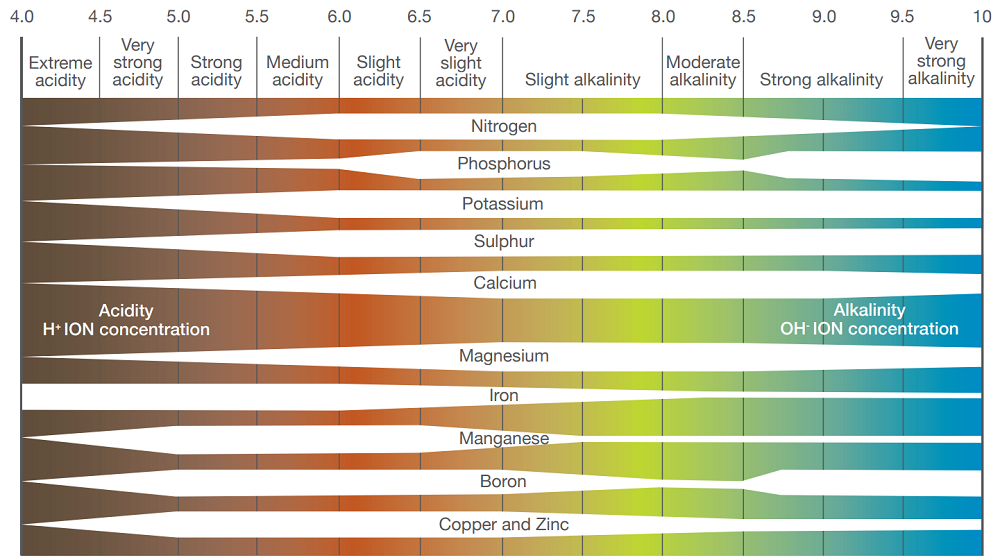- Home
- Knowledge library
- Soil pH and liming recommendations for arable and grass systems
Soil pH and liming recommendations for arable and grass systems
The AHDB Nutrient Management Guide (RB209) includes guidance on the management of soil acidity and alkalinity. Learn about optimum and target pH and lime recommendations for major crop systems and soil types.
Introduction to soil pH
A soil’s natural pH depends on the material from which it was formed.
Soil pH usually ranges from about 4 (very acidic), when most crops will fail, to about 8 (for soils rich in calcium carbonate or magnesium carbonate).
A soil with a pH of 6 is 10 times more acidic than a soil with a pH of 7.
Natural processes (e.g. leaching and crop growth) and farming practices (e.g. use of some nitrogen fertilisers) can acidify soil.
Acidifying processes rarely affect the pH of calcareous soils, except occasionally in the top few centimetres of undisturbed soil.
How to measure soil pH, nutrients and organic matter
Optimum and target soil pH
Failing to correct soil acidity can result in losses to crop yield and quality.
The optimum availability of most plant nutrients occurs over a small range of soil pH values (see chart).
Nutrient availability at a range of soil pH
 AHDB
AHDB
Maintaining soils at the optimum pH results in the best overall nutrient availability (see table).
Optimum and target pH for several soil types and cropping systems
|
Cropping system |
Mineral soils |
Peaty soils |
Organic |
Subsoil |
|
Continuous arable cropping |
6.5 (6.7) |
5.8 (6.0) |
6.0 (6.2) |
6.3 (6.5) |
|
Grass with an occasional barley crop |
6.2 (6.4) |
5.5 (5.7) |
5.7 (5.9) |
6.0 (6.2) |
|
Grass with an occasional wheat or oat crop |
6.0 (6.2) |
5.3 (5.5) |
5.5 (5.7) |
5.8 (6.0) |
|
Continuous grass or grass-clover swards |
6.0 (6.2) |
5.3 (5.5) |
5.5 (5.7) |
5.8 (6.0) |
Table notes:
- Target pH (shown in brackets) is 0.2 pH points above the optimum pH
- Nitrous oxide emissions are reduced by keeping pH at, or slightly above, the optimum
- Ensure that pH does not vary by more than ±0.5 pH points from the optimum
- Brassica crops in more acidic soils are at greater risk of clubroot
- A higher pH (up to 7.0) is justified where acid-sensitive crops are grown – for example, sugar beet, barley and clover
Main lime recommendations
Lime can be applied to make soil less acidic.
However, overuse of lime is wasteful and costly and can trigger trace element deficiencies and accelerate lime losses.
Main lime recommendations are usually for a 20 cm depth of cultivated soil or a 15 cm depth of grassland soil.
RB209 recommendations use ‘liming factors’ to account for the effect of soil type and cropping system (see table).
To estimate the lime requirement:
- Determine the difference between the soil’s initial (measured) and target pH.
- Multiply the difference by the liming factor for appropriate soil type and arable or grass system.
Example
- Liming factor for arable crop on sandy and loamy sands = 6
- Target pH for mineral soils in continuous arable cropping = 6.7
- Initial soil pH = 6.2
- Difference between target and initial = 0.5
- Lime requirement: 0.5 x 6 = 3 t/ha
Lime recommendations in RB209
|
Site information |
|
Initial soil pH and liming recommendation (t/ha) |
||||
|
Soil type |
System |
Liming factor |
6.2 |
6.0 |
5.5 |
5.0 |
|
Sands and loamy sands |
Arable |
6 |
3 |
4 |
7 |
10 |
|
Grass |
4 |
0 |
0 |
3 |
5 |
|
|
Sandy loams and silt loams |
Arable |
7 |
4 |
5 |
8 |
12 |
|
Grass |
5 |
0 |
0 |
4 |
6 |
|
|
Clay loams and clays |
Arable |
8 |
4 |
6 |
10 |
14 |
|
Grass |
6 |
0 |
0 |
4 |
7 |
|
|
Organic soils |
Arable |
8 |
4 |
6 |
10 |
14 |
|
Grass |
6 |
0 |
0 |
4 |
7 |
|
|
Peaty soils |
Arable |
16 |
0 |
0 |
8 |
16 |
|
Grass |
12 |
0 |
0 |
0 |
6 |
|
Table notes:
- Recommendations are based on ground limestone or chalk
- Always work liming material well into cultivated soil
- Consider reducing lime rates in stony soils – for example, if stones comprise 20% of the soil volume, reduce the lime rate by 20%
Neutralising value
The neutralising value (NV) indicates the relative effectiveness of a liming material compared with that of pure calcium oxide (CaO).
There are 24 recognised liming materials in the 1991 Fertilisers Regulations, including natural quarried limes, burnt and hydrated limes, silicate lime, seashells and lime sand, and industrial limes. In addition, other materials contain lime, including sugar beet lime and lime-treated sewage cake.
RB209 lime recommendations are based on ground limestone or ground chalk (NV 50–55).
Where other liming materials are used, it is important to account for differences in NV, in addition to fineness of grinding (which affects the speed of reaction in the soil) and cost.
Example
Ground limestone has an NV of 50 and costs £20/t delivered and spread.
Cost: (20 x 100) / 50 = 40p per unit of NV.
An alternative liming material has an NV of 30 and costs £17/t delivered and spread.
Costs (17 x 100) / 30 = 57p per unit of NV.
Provided the two materials have the same physical characteristics, the ground limestone is the more cost-effective liming material.
Note: It is important to account for the value of other nutrients in the liming material. For example, magnesian limestone (dolomitic limestone) contains large amounts of magnesium.
Correcting subsoil acidity
The amount of lime needed to correct subsoil (20–40 cm) acidity can be calculated using optimum pH values and liming factors of 5 for arable land or 4 for grassland.
For arable land, this lime can be ploughed down before the main lime application or applied in the following season.
For grassland, the amount of lime needed to correct subsoil acidity can be added to the main application.
In situations with minimal or no soil cultivation, apply no more than 7.5 t/ha of lime in one application (apply the balance in the following year).
As applications change the pH very slowly, it is important to prevent the underlying soil from becoming too acidic.
Further information
Access the Nutrient Management Guide (RB209)
Review of soil acidity and liming guidance
AgLime Quality Standard (AQS)
The AQS guarantees the regulatory quality of AQS-certified agricultural liming products on the UK market.
Agronomy Conference video
 AHDB
AHDB
Lime quantity and quality (Mark Tripney, LKAB Minerals and Kevin Havekes, Fane Valley)

